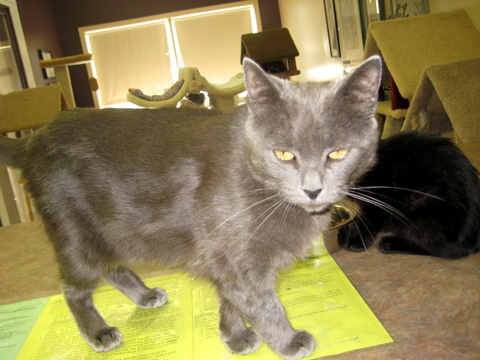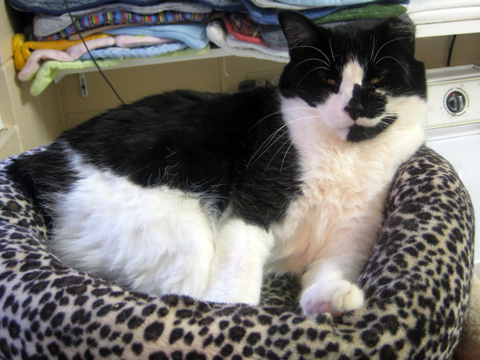De-Clawing

10 SEPARATE SURGICAL AMPUTATIONS
Before you make the decision to declaw your cat, there are some important facts you should know. Declawing (Onychectomy) is serious surgery. Your
cat's claw is not a fingernail. It is actually adhered to the bone; so closely adhered that to remove the claw, the last joint of your cat's “toe” is amputated.
When you envision that, it becomes clear why declawing is not a humane act. It is a painful surgery, with a painful recovery period. Laser surgery is just as invasive and catastrophic for the cat as the traditional surgical practice. During the time of recovery from the surgery, your cat would still have to use its feet to walk, jump, and scratch in its litter box regardless of the pain it is experiencing. Wheelchairs and bedpans are not an option for a cat.
No cat lover would doubt that cats - whose senses are much keener than ours - suffer pain. They may, however, hide it better. Not only are they proud, they instinctively know that they are at risk when in a weakened condition and by nature will attempt to hide it. But make no mistake, this is not a surgery to be taken lightly.
Your cat's body is perfectly designed to give it the grace, agility and beauty that is unique to felines. Its claws are an important part of this design. Amputating the part of their anatomy that contains the claws drastically alters the conformation of their feet. They are no longer able to hook their claws into their scratching post in order to stretch and align their backbones. The cat is also deprived of its primary means of defence, leaving it prey to predators if it ever escapes to the outdoors.
Scratching is a natural instinct for cats!
Psychological Side-Effects of Declawing
Some cats are so shocked by declawing that their personalities change. Cats who were lively and friendly have become withdrawn and introverted after being declawed. Others, deprived of their primary means of defence, become nervous, fearful, and/or aggressive, often resorting to their only remaining means of defence, their teeth.
In some cases, when declawed cats use the litter box after surgery,
their feet are so tender they associate their new pain with the box...permanently, resulting in a life-long aversion to using the litter box. Other declawed cats that can no longer mark with their claws, mark with urine instead resulting in inappropriate elimination problems. It is wrong to suggest that declawing will ensure the cat is retained by its owner. With all the problems that can result from declawing, it is no wonder many rescue groups and animal shelters end up with declawed cats in their systems. It is not uncommon for declawed cats to be surrendered due to behavioural problems that developed AFTER the cats were declawed. Of course, cats in animal shelters that have behavioural problems are often destroyed.

Many declawed cats become so traumatized by this painful mutilation that they end up spending their maladjusted lives perched on top of doors and refrigerators, out of reach of real and imaginary predators against whom they no longer have any adequate defence.
A cat relies on its claws as its primary means of defence. Removing the claws makes a cat feel defenceless. The constant state of stress caused by a feeling of defencelessness may make some declawed cats more prone to disease. Stress leads to a myriad of physical and psychological disorders including suppression of the immune system, cystitis and irritable bowel syndrome (IBS).
"The consequences of declawing are often pathetic. Changes in behaviour can occur. A declawed cat frequently resorts to biting when confronted with even minor threats. Biting becomes an overcompensation for the insecurity of having no claws. Bungled surgery can result in the re-growth of deformed claws or an infection leading to gangrene. Balance is affected by the inability to grasp with their claws. Chronic physical ailments such as cystitis or skin disorders can be manifestations of a declawed cat's frustration and stress."
- David E. Hammett, DVM
Anti-Declawing Laws
Many countries are particularly concerned about animal welfare and have banned declawing as abusive and causing unnecessary pain and suffering with no benefit to the cat. One highly regarded veterinary textbook by Turner and Bateson on the biology of cat behaviour concludes a short section on scratching behaviour with the following statement:
"The operative removal of the claws, as is sometimes practiced to protect furniture and curtains, is an act of abuse and should be forbidden by law in all, not just a few countries."
The following is a partial list of countries in which declawing cats is either illegal or considered extremely inhumane and only performed under extreme medical circumstances:
Australia, Austria, Belgium, Brazil, Denmark, Finland, France, Germany, Ireland, Israel, Italy, Japan, Northern Ireland, Netherlands, New Zealand, Northern Ireland, Norway, England, Portugal, Scotland, Slovenia, Spain, Sweden, Switzerland, Wales, Scotland and Yugoslavia. The list continues to grow.
Against declawing are the ASPCA, Canadian Federation of Humane Societies, Humane Society of the United States, Massachusetts SPCA, Denver Dumb Friends League, San Francisco SPCA, SPCA of Texas, and the Animal Welfare League (Chicago, IL, the Midwest's largest humane society). The SPCA of Los Angeles puts it in no uncertain terms: "We do NOT support, nor condone the act of declawing cats. It is cruel, unnecessary and inhumane." The Cat Fancier's Association, the world's largest pedigreed cat registry, opposes declawing as "without benefit to the cat".
